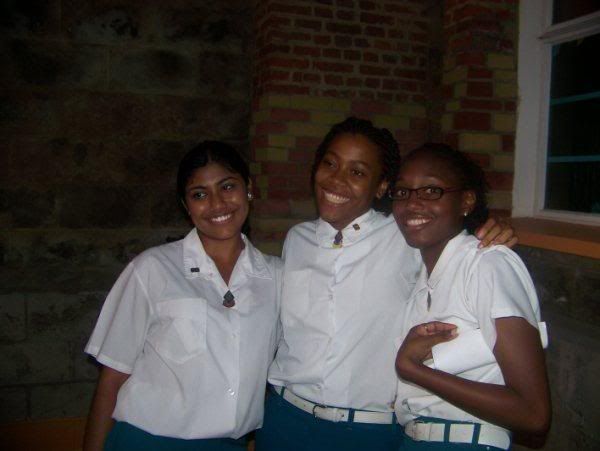The Prioress
For my version of the Canterbury Tales, I chose to recast my version of the prioress as a student of my high school, more specifically a student who was in my senior year; perhaps I might even venture to be so bold as to recast myself in the role of the Prioress but I feel any girl would have been a good choice because we were all exposed to the same thing as students of St. Joseph’s Convent, St. Joseph graduating in the same year.
Chaucer’s portrait of the Prioress in the General Prologue was that of a beautiful, charming, elegant, and very religious woman. He surprisingly did not find a particular flaw with her, nor did he try to highlight any particular vice through her or manipulate her character in any corrupt or lewd manner the way he did with his other pilgrims. His satire of her was subtle rather than scathing and so it gave me a relatively easy task because I don’t think any of the other corrupt pilgrims would have fit into the context of a Catholic high school appropriately.
I chose her for my character for various reasons. The first was that since my resetting of the Canterbury Tales occurred in my high school, which was a Catholic high school/convent and so we would be surrounded by Christianity and religion, I thought it fitting that my new “pilgrim” should be someone of similar religious background and thus the prioress was the obvious choice. Also, on a less important but nonetheless relevant note, another similarity between the students at my high school and the Prioress was that we even dressed alike. We dressed just like the Prioress did in that we wore uniforms to exemplify simplicity; the Prioress in the General Prologue was praised for her beauty in her modesty.
They make mention as well in the General Prologue that the Prioress wore a brooch on her religious garb that said “Amor vincit omnia” or “love conquers all”. We also had to wear badges on our uniform which read “Virtute et labore” – “virtues and labor”. The brooch I expect served as a reminder to the Prioress of something she was passionate about or wanted to emulate or even just something to remind her of what she was called to do or be. Similarly, “Virtute et labore” was our school motto and so we wore this to remind us of what we were to stand for and what was expected of us. (See Figs. 1 and 2)

Fig. 1. A snapshot of what a student’s badge looked like

Fig.2. Students wearing their uniforms and badges
Secondly, in the General Prologue, Chaucer mentions that “And French she spoke with elegant fluency after the School of Stratford at Bow” which gave me the impression that she was a learned woman, especially since French was considered one of the more elite languages of the day. This fit into the category of a school setting because that is essentially what we as the students of a high school would be there for - our scholastic education.
Chaucer goes on to describe the prioress as being kind and exceedingly well-mannered, especially focusing on her great etiquette and courtly demeanor. He illustrates her great compassion through her love for animals, especially her pet hounds. Even though I may not have appreciated it at the time or recognized it for what it was, those were just the kind of traits and behaviors the teachers (and nuns) strived to bring out in us. They always advocated a holistic education, that we should grow not only in knowledge, but also as human beings in the image of God and being called to love as He did, and emphasized the need for us to be “proper young ladies in society” - in dress, in modesty, in behavior, in all aspects; this is what the prioress herself made the effort to be. Her imitation of a woman of the royal court was in essence what we were taught to be at school.
And finally, what was ironic about the Prioress was that despite her moral exterior and her seemingly even more extensively moral tale, her tale had underlying tones of anti-Semitism. In the context of my setting, this would not translate directly into prejudice or hostility towards Jews, but rather discrimination in general. Since our high school was already so diverse, discrimination was understandably somewhat of a problem, especially given that it was a predominantly all-girls’ high school. We didn’t deal with discrimination in terms of religion or race, rather just the usual, and sadly inevitable, adolescent girl issues such as gossiping and criticizing and judging one another. These would be the underlying issues if one of the students had to retell the Prioress’ tale.
Moreover, the parallel here between the Prioress, her tale and the resetting of the Tales in my high school is that the Prioress was not perfect in spite of all her attempts to be and likewise, no matter how much the faculty and those in authority would try to mold us and nurture us into being young women who were like the Prioress, we too were not perfect and we too had our flaws. Thus is the curse of being human in that we are not God and we do falter. I am sure the Prioress did not intend to come across as being condemnatory, especially given her position; we too did not intend on being hurtful or spiteful towards one another, it was just unfortunately in our nature at that stage in our lives and thus were underlying problems we had to deal with.
With reference to my video, I tried to express how the students at my school were with each other and in the environment. The words of the poem interspersed throughout the video are the words of our school song. I also used pictures to convey similarities between the students in our everyday activities and the Prioress in hers. The music I chose for the background reflected the type of music one would expect to hear in a convent - the song was Ave Maria and it was sung in Latin and so I thought that this would have been extremely fitting for a Catholic school, and would be familiar to both the Prioress and to us students. I also thought the music conveyed a more subdued mood which in turn conveyed what reminded me of a Prioress – gentle and mild. I included myself because I thought that it would be appropriate to have something, no matter how small, of an actual student to capture the way we spoke and acted.
In conclusion, I chose the Prioress because she would have had the most in common with the environment I chose to reset my version of the Canterbury Tales. Since I myself was once a student there, I could relate to everything the Prioress represented, and moreover, so could any of the students who attended my high school, hence the reason I/they essentially became my new ‘pilgrim’.
Works Cited
Burne-Jones, Sir Edward Coley. “The Prioress’s Tale”. Web. February 20, 2010.
http://www.1st-art-gallery.com/Sir-Edward-Coley-Burne-Jones/The-Prioress%27 Tale.html
Chaucer, Geoffrey. “The General Prologue”. The Canterbury Tales: 9-11. 2007. Print. February 20, 2010.
Chaucer, Geoffrey. “The Prioress’ Prologue and Tale”. The Canterbury Tales: 521-535. 2007. Print. February 20, 2010.
Map of Trinidad and Tobago. Web. February 20,2010. http://wwp.greenwichmeantime.com/time-zone/caribbean/trinidad-tobago/map.htm
The Prioress’ Tale. Web. February 20, 2010. http://www.enc.edu/~delvyn.case/prioress/PRIORESS/Project.html
Snap shot of Trinidad. http://www.jonathanreedconsulting.com/images/trinidad.jpg
No comments:
Post a Comment